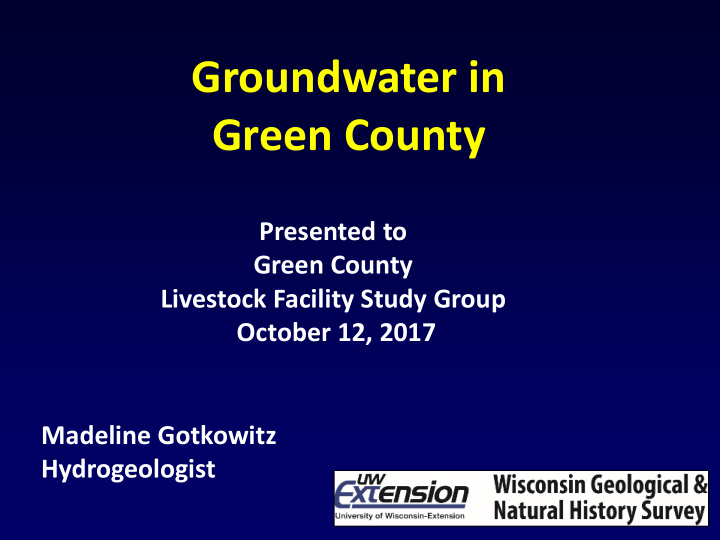



Groundwater in Green County Presented to Green County Livestock Facility Study Group October 12, 2017 Madeline Gotkowitz Hydrogeologist
Groundwater in Green County • Groundwater basics • Hydrogeology across Wisconsin • Green County • Hydrogeology • Wells and water use • Susceptibility to contamination
Wisconsin’s Water Cycle
Groundwater discharge to Honey Creek is “ baseflow ”
Hydrogeology: Groundwater flows through rock and sediment Water under the ground, within an aquifer; porous sand, gravel and rock holds water
sandstone shale Dolomite and limestone
Karst is a type of landscape Formed when soluble rocks, such as limestone and dolomite, dissolve Dissolution occurs because percolating rainwater is slightly acidic, pH about 5.7 Spectacular, well-developed karst systems feature large caves and sinkholes (Kentucky, New Mexico, Cave of the Mounds) Wisconsin’s karst features are relatively muted, with small sinkholes, enlarged fracture networks and conduits
20% of U.S. land surface is karst Weary and Doctor, 2014
crystalline rock sandstone carbonate
Carbonate rocks UNAME Su Silurian Sinnipee Os Prairie du Chien Opc
Sinnipee sandstone Mount Simon sandstone
Bedding plane fractures, Iowa County
Platteville Fm, Hwy 151 Lafayette County Horizontal Vertical
southwest northeast
Pathogens: bacteria, protozoa and viruses • Cause acute illness • Survival depends on temperature, moisture, and absence of UV light • Present in large numbers in human and animal waste • Septic systems, sewer systems, and manure Bacteria: Campylobacter , • Remain infectious on the Salmonella , E. coli O157:H7, Aeromonas order of 10s of months in groundwater
Pathogen transport Particulates and common diameters: (1 micron = 1 millionth of a meter) Human hair (~50-100 um) Rock fracture (1 – 1,000s um) Colloids (<0.2 um) Bacteria (~.2 – 20 um) Viruses (~0.005 um)
Porous media: slows groundwater transport, filters pathogens, dilutes dissolved contaminants (e.g. nitrate) Pore spaces filled with water Fractures: rapid transport, no filtration or contaminant decay
Karst landscape: dolomite and limestone are easily dissolved… Caves, sinkholes and fractures are common in this rock. Contaminants reach groundwater quickly…
Dodgeville Fleet Farm
Aquitards (confining unit) can partially separate aquifers USGS http://water.usgs.gov/edu/watercyclegwdischarge. html
Calumet and Brown Counties
Wisconsin’s groundwater contamination issues are significant… The left jar contains “brown water” contaminated by manure.
Karst features can be easy to see… Sinnipee Dolomite: Dane and Iowa Counties
Green County Hydrogeology
Depth to Bedrock
Green Co Bedrock Geology Cambrian sandstones and shales Prairie du Chien dolomite St Peter sandstone Platteville-Galena dolomite
Green County well construction (likely) Residential wells Municipal wells sand and gravel deposits Sinnipee dolomite (Galena, Platteville) St. Peter sandstone Prairie du Chein dolomite Wonewoc sandstone Eau Claire shale Mt. Simon sandstone
Wisconsin Groundwater Susceptibility Map Depth to bedrock, bedrock type, depth to groundwater, soil type, and surficial geologic material
Recommend
More recommend